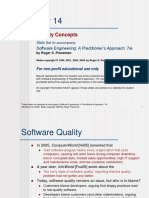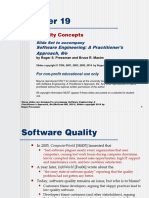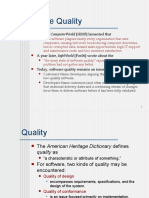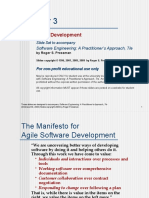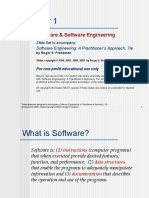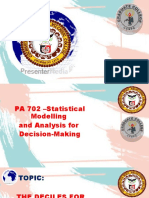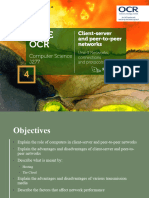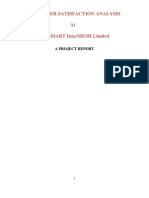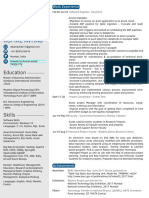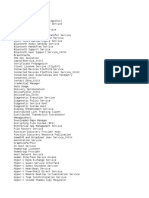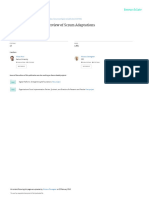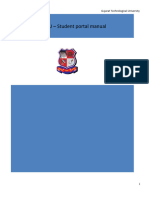0 ratings0% found this document useful (0 votes)
84 viewsQuality Concepts: Software Engineering: A Practitioner's Approach, 7/e
Quality Concepts: Software Engineering: A Practitioner's Approach, 7/e
Uploaded by
Jens Michelle de LaraSlides are designed to accompany software engineering: a practitioner's approach, 7 / e. Customers blame developers, arguing that sloppy practices lead to low-quality software. Developers argue that irrational delivery dates and a continuing stream of changes force them to deliver software before it has been fully validated.
Copyright:
Attribution Non-Commercial (BY-NC)
Available Formats
Download as PPT, PDF, TXT or read online from Scribd
Quality Concepts: Software Engineering: A Practitioner's Approach, 7/e
Quality Concepts: Software Engineering: A Practitioner's Approach, 7/e
Uploaded by
Jens Michelle de Lara0 ratings0% found this document useful (0 votes)
84 views20 pagesSlides are designed to accompany software engineering: a practitioner's approach, 7 / e. Customers blame developers, arguing that sloppy practices lead to low-quality software. Developers argue that irrational delivery dates and a continuing stream of changes force them to deliver software before it has been fully validated.
Original Title
Chapter 14
Copyright
© Attribution Non-Commercial (BY-NC)
Available Formats
PPT, PDF, TXT or read online from Scribd
Share this document
Did you find this document useful?
Is this content inappropriate?
Slides are designed to accompany software engineering: a practitioner's approach, 7 / e. Customers blame developers, arguing that sloppy practices lead to low-quality software. Developers argue that irrational delivery dates and a continuing stream of changes force them to deliver software before it has been fully validated.
Copyright:
Attribution Non-Commercial (BY-NC)
Available Formats
Download as PPT, PDF, TXT or read online from Scribd
Download as ppt, pdf, or txt
0 ratings0% found this document useful (0 votes)
84 views20 pagesQuality Concepts: Software Engineering: A Practitioner's Approach, 7/e
Quality Concepts: Software Engineering: A Practitioner's Approach, 7/e
Uploaded by
Jens Michelle de LaraSlides are designed to accompany software engineering: a practitioner's approach, 7 / e. Customers blame developers, arguing that sloppy practices lead to low-quality software. Developers argue that irrational delivery dates and a continuing stream of changes force them to deliver software before it has been fully validated.
Copyright:
Attribution Non-Commercial (BY-NC)
Available Formats
Download as PPT, PDF, TXT or read online from Scribd
Download as ppt, pdf, or txt
You are on page 1of 20
Chapter 14
Quality Concepts
Slide Set to accompany
Software Engineering: A Practitioner’s Approach, 7/e
by Roger S. Pressman
Slides copyright © 1996, 2001, 2005, 2009 by Roger S. Pressman
For non-profit educational use only
May be reproduced ONLY for student use at the university level when used in conjunction
with Software Engineering: A Practitioner's Approach, 7/e. Any other reproduction or use is
prohibited without the express written permission of the author.
All copyright information MUST appear if these slides are posted on a website for student
use.
These slides are designed to accompany Software Engineering: A Practitioner’s Approach,
7/e (McGraw-Hill, 2009). Slides copyright 2009 by Roger Pressman. 1
Software Quality
In 2005, ComputerWorld [Hil05] lamented that
“bad software plagues nearly every organization that uses
computers, causing lost work hours during computer downtime,
lost or corrupted data, missed sales opportunities, high IT support
and maintenance costs, and low customer satisfaction.
A year later, InfoWorld [Fos06] wrote about the
“the sorry state of software quality” reporting that the quality
problem had not gotten any better.
Today, software quality remains an issue, but who is to blame?
Customers blame developers, arguing that sloppy practices lead to
low-quality software.
Developers blame customers (and other stakeholders), arguing
that irrational delivery dates and a continuing stream of changes
force them to deliver software before it has been fully validated.
These slides are designed to accompany Software Engineering: A Practitioner’s Approach,
7/e (McGraw-Hill, 2009). Slides copyright 2009 by Roger Pressman. 2
Quality
The American Heritage Dictionary defines
quality as
“a characteristic or attribute of something.”
For software, two kinds of quality may be
encountered:
Quality of design encompasses requirements,
specifications, and the design of the system.
Quality of conformance is an issue focused primarily
on implementation.
User satisfaction = compliant product + good quality
+ delivery within budget and schedule
These slides are designed to accompany Software Engineering: A Practitioner’s Approach,
7/e (McGraw-Hill, 2009). Slides copyright 2009 by Roger Pressman. 3
Quality—A Philosophical View
Robert Persig [Per74] commented on the thing we call
quality:
Quality . . . you know what it is, yet you don't know what it is.
But that's self-contradictory. But some things are better than
others, that is, they have more quality. But when you try to say
what the quality is, apart from the things that have it, it all goes
poof! There's nothing to talk about. But if you can't say what
Quality is, how do you know what it is, or how do you know that
it even exists? If no one knows what it is, then for all practical
purposes it doesn't exist at all. But for all practical purposes it
really does exist. What else are the grades based on? Why else
would people pay fortunes for some things and throw others in
the trash pile? Obviously some things are better than others . . .
but what's the betterness? . . . So round and round you go,
spinning mental wheels and nowhere finding anyplace to get
traction. What the hell is Quality? What is it?
These slides are designed to accompany Software Engineering: A Practitioner’s Approach,
7/e (McGraw-Hill, 2009). Slides copyright 2009 by Roger Pressman. 4
Quality—A Pragmatic View
The transcendental view argues (like Persig) that quality is
something that you immediately recognize, but cannot
explicitly define.
The user view sees quality in terms of an end-user’s specific
goals. If a product meets those goals, it exhibits quality.
The manufacturer’s view defines quality in terms of the
original specification of the product. If the product
conforms to the spec, it exhibits quality.
The product view suggests that quality can be tied to
inherent characteristics (e.g., functions and features) of a
product.
Finally, the value-based view measures quality based on
how much a customer is willing to pay for a product. In
reality, quality encompasses all of these views and more.
These slides are designed to accompany Software Engineering: A Practitioner’s Approach,
7/e (McGraw-Hill, 2009). Slides copyright 2009 by Roger Pressman. 5
Software Quality
Software quality can be defined as:
An effective software process applied in a manner that
creates a useful product that provides measurable value for
those who produce it and those who use it.
This definition has been adapted from [Bes04] and
replaces a more manufacturing-oriented view
presented in earlier editions of this book.
These slides are designed to accompany Software Engineering: A Practitioner’s Approach,
7/e (McGraw-Hill, 2009). Slides copyright 2009 by Roger Pressman. 6
Effective Software Process
An effective software process establishes the infrastructure
that supports any effort at building a high quality
software product.
The management aspects of process create the checks
and balances that help avoid project chaos—a key
contributor to poor quality.
Software engineering practices allow the developer to
analyze the problem and design a solid solution—both
critical to building high quality software.
Finally, umbrella activities such as change management
and technical reviews have as much to do with quality
as any other part of software engineering practice.
These slides are designed to accompany Software Engineering: A Practitioner’s Approach,
7/e (McGraw-Hill, 2009). Slides copyright 2009 by Roger Pressman. 7
Useful Product
A useful product delivers the content, functions,
and features that the end-user desires
But as important, it delivers these assets in a
reliable, error free way.
A useful product always satisfies those
requirements that have been explicitly stated
by stakeholders.
In addition, it satisfies a set of implicit
requirements (e.g., ease of use) that are
expected of all high quality software.
These slides are designed to accompany Software Engineering: A Practitioner’s Approach,
7/e (McGraw-Hill, 2009). Slides copyright 2009 by Roger Pressman. 8
Adding Value
By adding value for both the producer and user of a software
product, high quality software provides benefits for the
software organization and the end-user community.
The software organization gains added value because high
quality software requires less maintenance effort, fewer bug
fixes, and reduced customer support.
The user community gains added value because the
application provides a useful capability in a way that
expedites some business process.
The end result is:
(1) greater software product revenue,
(2) better profitability when an application supports a business
process, and/or
(3) improved availability of information that is crucial for the
business.
These slides are designed to accompany Software Engineering: A Practitioner’s Approach,
7/e (McGraw-Hill, 2009). Slides copyright 2009 by Roger Pressman. 9
Quality Dimensions
David Garvin [Gar87]:
Performance Quality. Does the software deliver all
content, functions, and features that are specified as part of
the requirements model in a way that provides value to the
end-user?
Feature quality. Does the software provide features that
surprise and delight first-time end-users?
Reliability. Does the software deliver all features and
capability without failure? Is it available when it is
needed? Does it deliver functionality that is error free?
Conformance. Does the software conform to local and
external software standards that are relevant to the
application? Does it conform to de facto design and coding
conventions? For example, does the user interface conform
to accepted design rules for menu selection or data input?
These slides are designed to accompany Software Engineering: A Practitioner’s Approach,
7/e (McGraw-Hill, 2009). Slides copyright 2009 by Roger Pressman. 10
Quality Dimensions
Durability. Can the software be maintained (changed) or
corrected (debugged) without the inadvertent generation
of unintended side effects? Will changes cause the error
rate or reliability to degrade with time?
Serviceability. Can the software be maintained (changed)
or corrected (debugged) in an acceptably short time period.
Can support staff acquire all information they need to
make changes or correct defects?
Aesthetics. Most of us would agree that an aesthetic entity has a
certain elegance, a unique flow, and an obvious “presence” that
are hard to quantify but evident nonetheless.
Perception. In some situations, you have a set of prejudices that
will influence your perception of quality.
These slides are designed to accompany Software Engineering: A Practitioner’s Approach,
7/e (McGraw-Hill, 2009). Slides copyright 2009 by Roger Pressman. 11
Other Views
McCall’s Quality Factors (SEPA, Section
14.2.2)
ISO 9126 Quality Factors (SEPA, Section
14.2.3)
Targeted Factors (SEPA, Section 14.2.4)
These slides are designed to accompany Software Engineering: A Practitioner’s Approach,
7/e (McGraw-Hill, 2009). Slides copyright 2009 by Roger Pressman. 12
The Software Quality Dilemma
If you produce a software system that has terrible quality,
you lose because no one will want to buy it.
If on the other hand you spend infinite time, extremely
large effort, and huge sums of money to build the
absolutely perfect piece of software, then it's going to take
so long to complete and it will be so expensive to produce
that you'll be out of business anyway.
Either you missed the market window, or you simply
exhausted all your resources.
So people in industry try to get to that magical middle
ground where the product is good enough not to be
rejected right away, such as during evaluation, but also not
the object of so much perfectionism and so much work that
it would take too long or cost too much to complete.
[Ven03]
These slides are designed to accompany Software Engineering: A Practitioner’s Approach,
7/e (McGraw-Hill, 2009). Slides copyright 2009 by Roger Pressman. 13
“Good Enough” Software
Good enough software delivers high quality functions and
features that end-users desire, but at the same time it delivers
other more obscure or specialized functions and features that
contain known bugs.
Arguments against “good enough.”
It is true that “good enough” may work in some application
domains and for a few major software companies. After all, if a
company has a large marketing budget and can convince enough
people to buy version 1.0, it has succeeded in locking them in.
If you work for a small company be wary of this philosophy. If you
deliver a “good enough” (buggy) product, you risk permanent
damage to your company’s reputation.
You may never get a chance to deliver version 2.0 because bad buzz
may cause your sales to plummet and your company to fold.
If you work in certain application domains (e.g., real time embedded
software, application software that is integrated with hardware can
be negligent and open your company to expensive litigation.
These slides are designed to accompany Software Engineering: A Practitioner’s Approach,
7/e (McGraw-Hill, 2009). Slides copyright 2009 by Roger Pressman. 14
Cost of Quality
Prevention costs include
quality planning
formal technical reviews
test equipment
Training
Internal failure costs include
rework
repair
failure mode analysis
External failure costs are
complaint resolution
product return and replacement
help line support
warranty work
These slides are designed to accompany Software Engineering: A Practitioner’s Approach,
7/e (McGraw-Hill, 2009). Slides copyright 2009 by Roger Pressman. 15
Cost
The relative costs to find and repair an error or defect
increase dramatically as we go from prevention to
detection to internal failure to external failure costs.
These slides are designed to accompany Software Engineering: A Practitioner’s Approach,
7/e (McGraw-Hill, 2009). Slides copyright 2009 by Roger Pressman. 16
Quality and Risk
“People bet their jobs, their comforts, their safety, their
entertainment, their decisions, and their very lives on
computer software. It better be right.” SEPA, Chapter 1
Example:
Throughout the month of November, 2000 at a hospital in
Panama, 28 patients received massive overdoses of gamma rays
during treatment for a variety of cancers. In the months that
followed, five of these patients died from radiation poisoning and
15 others developed serious complications. What caused this
tragedy? A software package, developed by a U.S. company, was
modified by hospital technicians to compute modified doses of
radiation for each patient.
These slides are designed to accompany Software Engineering: A Practitioner’s Approach,
7/e (McGraw-Hill, 2009). Slides copyright 2009 by Roger Pressman. 17
Negligence and Liability
The story is all too common. A governmental or corporate
entity hires a major software developer or consulting
company to analyze requirements and then design and
construct a software-based “system” to support some
major activity.
The system might support a major corporate function (e.g.,
pension management) or some governmental function (e.g.,
healthcare administration or homeland security).
Work begins with the best of intentions on both sides, but
by the time the system is delivered, things have gone bad.
The system is late, fails to deliver desired features and
functions, is error-prone, and does not meet with
customer approval.
Litigation ensues.
These slides are designed to accompany Software Engineering: A Practitioner’s Approach,
7/e (McGraw-Hill, 2009). Slides copyright 2009 by Roger Pressman. 18
Quality and Security
Gary McGraw comments [Wil05]:
“Software security relates entirely and completely to
quality. You must think about security, reliability,
availability, dependability—at the beginning, in the
design, architecture, test, and coding phases, all through
the software life cycle [process]. Even people aware of
the software security problem have focused on late life-
cycle stuff. The earlier you find the software problem,
the better. And there are two kinds of software
problems. One is bugs, which are implementation
problems. The other is software flaws—architectural
problems in the design. People pay too much attention
to bugs and not enough on flaws.”
These slides are designed to accompany Software Engineering: A Practitioner’s Approach,
7/e (McGraw-Hill, 2009). Slides copyright 2009 by Roger Pressman. 19
Achieving Software Quality
Critical success factors:
Software Engineering Methods
Project Management Techniques
Quality Control
Quality Assurance
These slides are designed to accompany Software Engineering: A Practitioner’s Approach,
7/e (McGraw-Hill, 2009). Slides copyright 2009 by Roger Pressman. 20
You might also like
- Acer Predator 17 G9-793 - Pegatron MU5DC CH7DC REV 2.0Document86 pagesAcer Predator 17 G9-793 - Pegatron MU5DC CH7DC REV 2.0xingyiservice.mdy123No ratings yet
- Best Buy Receipt AppliancesDocument2 pagesBest Buy Receipt Appliancesggo191702No ratings yet
- Software Engineering A Practitioner's Approach - Roger S. PressmanDocument439 pagesSoftware Engineering A Practitioner's Approach - Roger S. PressmanRanbir50% (2)
- Week 12Document28 pagesWeek 12hiraali8938No ratings yet
- Quality Concepts: Software Engineering: A Practitioner's Approach, 7/eDocument29 pagesQuality Concepts: Software Engineering: A Practitioner's Approach, 7/eaqsa riazNo ratings yet
- Chapter 19 - Quality ConceptsDocument22 pagesChapter 19 - Quality Concepts404xenosNo ratings yet
- Quality ConceptsDocument20 pagesQuality Conceptsleveke5755No ratings yet
- Quality ConceptsDocument7 pagesQuality ConceptsSteve IrwinNo ratings yet
- Software Quality: in 2005, Computerworld (Hil05) Lamented ThatDocument32 pagesSoftware Quality: in 2005, Computerworld (Hil05) Lamented ThatswetaNo ratings yet
- 3 Chapter - 03 Agile DevelopmentDocument27 pages3 Chapter - 03 Agile DevelopmentAzka FatimaNo ratings yet
- SEPA8 e Slides CH 2 R1Document16 pagesSEPA8 e Slides CH 2 R1mdownload271No ratings yet
- Introduction To Se: Bui Thi Mai AnhDocument32 pagesIntroduction To Se: Bui Thi Mai AnhPhạm Đình ThắngNo ratings yet
- UNIT V - 7 Software Process ImprovementsDocument20 pagesUNIT V - 7 Software Process ImprovementsDevnathNo ratings yet
- Ch02 3softwareDocument22 pagesCh02 3softwareMatthews TladiNo ratings yet
- 02 SoftwareProcessDocument57 pages02 SoftwareProcessparsa.shafagh.1382No ratings yet
- Software Quality Assurance: Software Engineering: A Practitioner's Approach, 7/eDocument12 pagesSoftware Quality Assurance: Software Engineering: A Practitioner's Approach, 7/emalik assadNo ratings yet
- 03 Agile DevelopmentDocument27 pages03 Agile DevelopmentShafa-at AliNo ratings yet
- Software Product Quality: Theory, Model, and PracticeDocument31 pagesSoftware Product Quality: Theory, Model, and Practiceapi-3738458No ratings yet
- CH 05Document58 pagesCH 05tarunsood2009No ratings yet
- Agile Development Software EngineeringDocument47 pagesAgile Development Software EngineeringShabana TahirNo ratings yet
- Software Quality Assurance: Software Engineering: A Practitioner' S Approach, 7/eDocument12 pagesSoftware Quality Assurance: Software Engineering: A Practitioner' S Approach, 7/eNujhatShejutyNo ratings yet
- Se361 Chapter 03Document4 pagesSe361 Chapter 03PurvaNo ratings yet
- Se361 Chapter 03Document4 pagesSe361 Chapter 03RashedulNo ratings yet
- Se 3Document36 pagesSe 3Ali AmjadNo ratings yet
- Agile Software DevelopmentDocument21 pagesAgile Software DevelopmentSiddharth BangaNo ratings yet
- Agile Development: Software Engineering: A Practitioner's Approach, 7/eDocument21 pagesAgile Development: Software Engineering: A Practitioner's Approach, 7/eYELCHURI VENKATA NAGASAI RAVI TEJA100% (1)
- SPM Week 4 - Agile PMDocument10 pagesSPM Week 4 - Agile PMMohammad ZawarNo ratings yet
- Chapter 1 - IntroductionDocument32 pagesChapter 1 - Introductionmalik assadNo ratings yet
- Chapter 5 - Requirement Gathering-1Document45 pagesChapter 5 - Requirement Gathering-1Sadaf HameedNo ratings yet
- Chapter 8Document26 pagesChapter 8213808itNo ratings yet
- Software and Software EngineeringDocument60 pagesSoftware and Software EngineeringprasadbbnNo ratings yet
- Ch01 SoftwareDocument14 pagesCh01 SoftwareMatthews TladiNo ratings yet
- SJB Institute of Technology: Question Bank Lecture NotesDocument22 pagesSJB Institute of Technology: Question Bank Lecture NotesMandira KumarNo ratings yet
- Chapter 01Document8 pagesChapter 01dbNo ratings yet
- Software & Software EngineeringDocument10 pagesSoftware & Software Engineeringm_saki6665803No ratings yet
- Chapter - 01 (Salinan Berkonflik Sistem Informasi 2013-09-12)Document24 pagesChapter - 01 (Salinan Berkonflik Sistem Informasi 2013-09-12)Nazilatul MahbubahNo ratings yet
- On ReengineeringDocument17 pagesOn ReengineeringChaitanyaKaul100% (1)
- Software & Software EngineeringDocument439 pagesSoftware & Software EngineeringShilpika AgarwalNo ratings yet
- Project Management Concepts: Software Engineering: A Practitioner's Approach, 7/eDocument18 pagesProject Management Concepts: Software Engineering: A Practitioner's Approach, 7/ePranav HirulkarNo ratings yet
- Process ModelsDocument83 pagesProcess ModelsKrupa JananiNo ratings yet
- SEPA8 e Slides CH 5 R1Document18 pagesSEPA8 e Slides CH 5 R1mdownload271No ratings yet
- Lecture p1 AutosavedDocument23 pagesLecture p1 AutosavedAhad ShahNo ratings yet
- Agile Development: Slide Set To AccompanyDocument15 pagesAgile Development: Slide Set To AccompanysadNo ratings yet
- The Multimedia Development ProcessDocument2 pagesThe Multimedia Development ProcessKyrelle Pauline Dimacutac SolisNo ratings yet
- Quality Concepts: Software Engineering: A Practitioner's Approach, 7/eDocument18 pagesQuality Concepts: Software Engineering: A Practitioner's Approach, 7/eomer samiNo ratings yet
- Understanding Requirements: Software Engineering: A Practitioner's Approach, 7/eDocument27 pagesUnderstanding Requirements: Software Engineering: A Practitioner's Approach, 7/edevNo ratings yet
- Chapter 3 - Agile Process ModelDocument28 pagesChapter 3 - Agile Process ModelTayseerNo ratings yet
- 02 - Software Quality ModelsDocument48 pages02 - Software Quality ModelsMuhammad AsfandNo ratings yet
- Pressman 7 CH 25 MetricsDocument20 pagesPressman 7 CH 25 MetricsmailNo ratings yet
- Chapter 21Document17 pagesChapter 21213808itNo ratings yet
- Product Metrics 2023Document36 pagesProduct Metrics 2023leveke5755No ratings yet
- Unit 1 FSDDocument50 pagesUnit 1 FSDRoshni RaichandaniNo ratings yet
- Software Engineering A Practitioner's Approach - Roger S. PressmanDocument439 pagesSoftware Engineering A Practitioner's Approach - Roger S. Pressmank225254 Ramisha MukhtarNo ratings yet
- Notes Sepm Unit 1Document43 pagesNotes Sepm Unit 1Abdul Wasiq KhanNo ratings yet
- Week1 Chapter2Document29 pagesWeek1 Chapter2Abdelrahman ElfarNo ratings yet
- Chapter 2Document23 pagesChapter 2213808itNo ratings yet
- Real-World Solutions for Developing High-Quality PHP Frameworks and ApplicationsFrom EverandReal-World Solutions for Developing High-Quality PHP Frameworks and ApplicationsRating: 2.5 out of 5 stars2.5/5 (2)
- Software Testing Interview Questions You'll Most Likely Be AskedFrom EverandSoftware Testing Interview Questions You'll Most Likely Be AskedNo ratings yet
- Cost Estimation in Agile Software Development: Utilizing Functional Size Measurement MethodsFrom EverandCost Estimation in Agile Software Development: Utilizing Functional Size Measurement MethodsNo ratings yet
- Picture Processing by Computer Azriel Rosenfeld: University of Maryland, College Park, MarylandDocument28 pagesPicture Processing by Computer Azriel Rosenfeld: University of Maryland, College Park, MarylandJohn WestonNo ratings yet
- Pa 702-The Deciles For Ungrouped and Grouped DataDocument30 pagesPa 702-The Deciles For Ungrouped and Grouped DataEmmel Solaiman AkmadNo ratings yet
- T4 Client-Server Networks 2Document37 pagesT4 Client-Server Networks 2hg eagleNo ratings yet
- Virtual IzationDocument3 pagesVirtual Izationaravindan476No ratings yet
- B-Hero App: 1) Background/ Problem StatementDocument7 pagesB-Hero App: 1) Background/ Problem StatementMarvin LucasNo ratings yet
- Oracle 12c RAC - Quick Guide To GIMR AdministrationDocument10 pagesOracle 12c RAC - Quick Guide To GIMR Administrationmiguelangel.mirandarios1109No ratings yet
- g9 2nd OrigamiDocument101 pagesg9 2nd OrigamiPrimrose MazoNo ratings yet
- CG - Unit-II MCQDocument23 pagesCG - Unit-II MCQSE 18 Ganesh pawarNo ratings yet
- Indiamart Intermesh Limited - Project ReportDocument93 pagesIndiamart Intermesh Limited - Project Reportdhavalshukla77% (13)
- Setup WizardDocument42 pagesSetup WizardAndreea NistorNo ratings yet
- 1.4 Storage NotesDocument2 pages1.4 Storage NotesMuhammad BilalNo ratings yet
- Assignment # 2: ProcedureDocument14 pagesAssignment # 2: ProcedureHumza ZahidNo ratings yet
- KomalalkazureDocument2 pagesKomalalkazureshrinithi VNo ratings yet
- Troubleshooting PDFDocument1 pageTroubleshooting PDFSanVaisenNo ratings yet
- 1 Services That Get DisabledDocument3 pages1 Services That Get DisabledRUOBAPELAONo ratings yet
- 2-2 Sales SPV TrainingDocument9 pages2-2 Sales SPV Training'Bernard Fernando Xav Monroe'No ratings yet
- Silo - Tips - Arabic Mathematical Symbol Insertion Application System Using Arabic Pack For Math Type SoftwareDocument8 pagesSilo - Tips - Arabic Mathematical Symbol Insertion Application System Using Arabic Pack For Math Type SoftwareMamhayMath magicNo ratings yet
- DUW INTEGRATION@telecomiDocument85 pagesDUW INTEGRATION@telecomiSaif AbdullahNo ratings yet
- Inventario de HadwareDocument57 pagesInventario de HadwareKelly Johanna BARRERA ORDONEZNo ratings yet
- Hakdog: Free Text OnlyDocument3 pagesHakdog: Free Text OnlySheila B. ParadoNo ratings yet
- Scrum in Practice An Overview of Scrum AdaptationsDocument11 pagesScrum in Practice An Overview of Scrum AdaptationsNabila NurazizahNo ratings yet
- Nilab Khalily: EducationDocument1 pageNilab Khalily: EducationnelabkhalilyNo ratings yet
- Aamadu Male 41 IphoneDocument4 pagesAamadu Male 41 IphoneRin XinhNo ratings yet
- Annexure 2 - 596261 (1) - 240319 - 161900Document39 pagesAnnexure 2 - 596261 (1) - 240319 - 161900dhanyagajjar05No ratings yet
- Report Painter COPADocument15 pagesReport Painter COPARajashree Sirsikar50% (2)
- 10 C's of Amazon: Submitted By: DIVYA PANTA (21109) Jyoti SinghDocument51 pages10 C's of Amazon: Submitted By: DIVYA PANTA (21109) Jyoti SinghDivya PantaNo ratings yet
- Python ListsDocument4 pagesPython ListsPawan NaniNo ratings yet
- Vu+ Uno 4K SE ReviewDocument19 pagesVu+ Uno 4K SE ReviewOmar Mohammed FathyNo ratings yet





